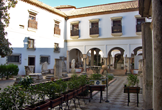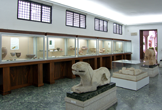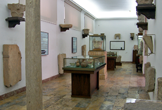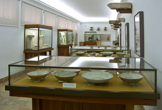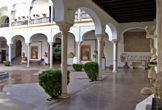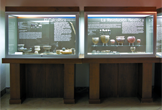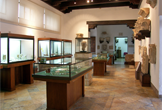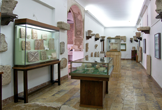Archaeological and Ethnological Museum
In 1844 all the works seized from convents in Córdoba were gathered and deposited in the <a href=”https://www.artencordoba.com/fotos/museos/museum-fine-arts-cordoba/”>Provincial Museum of Fine Arts</a>, constituting the “Antiques Collection”. As part of the <i>Museum of Fine Arts</i>, the collection suffered the different moves of the museum, until it was finally located in the old <i>Hospital of Charity</i>, in <a href=”https://www.artencordoba.com/fotos/plazas/square-potro-colt-cordoba/”>Potro Square</a>, which is its current location.
It was in 1867 when the <b>Provincial Archaeological Museum of Córdoba</b> was officially opened. However, it shared the building with the <i>Museum of Fine Arts</i> until 1920, when the collection was transferred to San Juan de Letrán Square. However, the <b>museum</b> was transferred again five years later, this time to Samuel de los Santos Gener Street (who was the director of the museum), near the <a href=”https://www.artencordoba.com/en/mosque-cordoba/mosque-cathedral/”>Mosque-Cathedral</a>.
In 1960 the <b>museum</b> was finally set in the Renaissance Palace of Páez de Castillejo, and two years later, both the building and the collection were declared “Artistic Historical Monument”. Since then, the <b>Archaeological Museum of Córdoba</b> has consolidated as one of the most complete museums of this kind in Spain, it has considerably and constantly increased its heritage, and it has promoted numerous initiatives, such as the creation of the scientific magazine “Corduba Archaeologica”, the building of an exceptional specialized library or the creation of the Research Service on Urban Archaeology.
<i>Palace of Páez de Castillejo</i> dates back to the 16th century, and it is built on the remains on the old <a href=”https://www.artencordoba.com/fotos/cordoba-romana/roman-theatre/”>Roman theatre</a> of the city. That is why one of the halls of the <b>museum</b> has part of its stalls. From the palace, although it has been reformed, we can highlight the two big arcaded courtyards, designed by Hernán Ruiz the Old, around which the different halls of the <b>museum</b> are arranged. The main façade, as well as the main stairway were made by Hernán Ruiz II, the Young, around 1540 approximately. It was conceived as a triumphal arch, and it develops an iconographic programme aimed at highlighting the family Páez de Castillejo.
<p align=”center”>HALLS OF THE MUSEUM</p>
HALL I: <i>Prehistory</i> – [Photo <a href=”https://www.artencordoba.com/fotos/museos/PHOTOS/ARCHAEOLOGICAL_MUSEUM/ARCHAEOLOGICAL_MUSEUM_CORDOBA_05.jpg” target=”_blank” rel=”noopener noreferrer”>#1</a>; <a href=”https://www.artencordoba.com/fotos/museos/PHOTOS/ARCHAEOLOGICAL_MUSEUM/ARCHAEOLOGICAL_MUSEUM_CORDOBA_06.jpg” target=”_blank” rel=”noopener noreferrer”>#2</a>]
The first hall of the museum is dedicated to Prehistory. We can see remains from a period between the Lower Paleolithic and the Middle Bronze Age. The remains are displayed in several glass cabinets arranged in different periods of the Prehistory.
We must highlight the second glass cabinet, dedicated to the Neolithic Revolution, characterised by the change from a predatory to a productive economy. This was reflected on the appearance of the first ceramic pots. We should also mention the remains from the Cueva de los Murciélagos (Cave of the Bats).
HALL II: <i>Protohistory</i> – [Photo <a href=”https://www.artencordoba.com/fotos/museos/PHOTOS/ARCHAEOLOGICAL_MUSEUM/ARCHAEOLOGICAL_MUSEUM_CORDOBA_15.jpg” target=”_blank” rel=”noopener noreferrer”>#1</a>; <a href=”https://www.artencordoba.com/fotos/museos/PHOTOS/ARCHAEOLOGICAL_MUSEUM/ARCHAEOLOGICAL_MUSEUM_CORDOBA_16.jpg” target=”_blank” rel=”noopener noreferrer”>#2</a>]
Next to the first hall, we can see the one dedicated to Protohistory, a period that extends from the end of the 2nd millennium until the 2nd century BC. We can see there remains of the sites Llanete de los Moros or La Colina de los Quemados in Córdoba, from the end of the Bronze Age.
We must also highlight the remains from the Iberian-Turdetani Culture, dated between the 6th and 2nd centuries BC. A wide range of zoomorphic sculptures, weapons, pottery… is displayed, which was taken from several sites in the province.
HALLS III-V: <i>Roman Culture</i>– [Photo <a href=”https://www.artencordoba.com/fotos/museos/PHOTOS/ARCHAEOLOGICAL_MUSEUM/ARCHAEOLOGICAL_MUSEUM_CORDOBA_09.jpg” target=”_blank” rel=”noopener noreferrer”>#1</a>; <a href=”https://www.artencordoba.com/fotos/museos/PHOTOS/ARCHAEOLOGICAL_MUSEUM/ARCHAEOLOGICAL_MUSEUM_CORDOBA_10.jpg” target=”_blank” rel=”noopener noreferrer”>#2</a>]
We go across the second courtyard to enter the three halls dedicated to Roman culture. As we explained in the section dedicated to Roman Córdoba, our city had a very important role in this period of our history, it was the capital of the Bética and, later, it was named Colonia Patricia. This is reflected on the remains that have been preserved.
In this hall we can see sculptures, tombs, mosaics, models of monuments… even the remains of the stalls of the theatre of the city, which will be opened to the public soon.
HALL VI: <i>Visigothic Art</i>– [Photo <a href=”https://www.artencordoba.com/fotos/museos/PHOTOS/ARCHAEOLOGICAL_MUSEUM/ARCHAEOLOGICAL_MUSEUM_CORDOBA_11.jpg” target=”_blank” rel=”noopener noreferrer”>#1</a>; <a href=”https://www.artencordoba.com/fotos/museos/PHOTOS/ARCHAEOLOGICAL_MUSEUM/ARCHAEOLOGICAL_MUSEUM_CORDOBA_12.jpg” target=”_blank” rel=”noopener noreferrer”>#2</a>]
We finish our tour on the ground floor of the museum with the hall dedicated to Visigothic Art. We know very little about the structure of our city at this time, but we have preserved numerous material remains. This collection is, together with the <a href=”https://www.artencordoba.com/en/mosque-cordoba/visigoth-basilica-san-vicente/”>Museum of San Vicente</a> in the Cathedral, the most complete collection on the period in the city.
We can see there remains of tombs, of architectonic elements, such as carved capitals, pottery brought from basilicas located in the mountains, silversmithing…
HALLS VII-VIII: <i>Al-Andalus</i> – [Photo <a href=”https://www.artencordoba.com/fotos/museos/PHOTOS/ARCHAEOLOGICAL_MUSEUM/ARCHAEOLOGICAL_MUSEUM_CORDOBA_13.jpg” target=”_blank” rel=”noopener noreferrer”>#1</a>; <a href=”https://www.artencordoba.com/fotos/museos/PHOTOS/ARCHAEOLOGICAL_MUSEUM/ARCHAEOLOGICAL_MUSEUM_CORDOBA_14.jpg” target=”_blank” rel=”noopener noreferrer”>#2</a>]
On the second floor of this large building we can find the last stop of our tour, Islamic culture.
We start our tour at the arcaded galleries of the courtyard, where we can see a wide variety of architectonic remains (bases, capitals…) of all kinds. Hall VII is exclusively dedicated to the remains found in <a href=”https://www.artencordoba.com/en/azahara-medina/madinat-alzahra-cordoba/”>Medina Azahara</a>. Finally, in Hall VIII we can see metal pieces, most of them in bronze, and also many silversmithing pieces.
<p align=”center”>UNIQUE WORKS</p>
<b>Iberian Lion from Nueva Carteya</b> – [<a href=”https://www.artencordoba.com/fotos/museos/PHOTOS/ARCHAEOLOGICAL_MUSEUM/ARCHAEOLOGICAL_MUSEUM_CORDOBA_IBERIAN_LION_NUEVA_CARTEYA.jpg” target=”_blank” rel=”noopener noreferrer”>PHOTO</a>].
Anonymous.
Limestone.
Length: 114.5 cm. / Height: 61 / Width: 23 cm.
Date: 4th century BC
The lion is the most frequently represented animal and it carries a great symbolic meaning, as ancient Mediterranean cultures directly related it to royalty. They were supposed to protect the graves of those characters who were powerful in their communities. These representations also had a certain mythological character, almost fantastic, since these animals did not live in the Iberian Peninsula naturally. They are usually represented with their jaws opened, with large fungs among which the tongue could be seen, in an intentionally threatening attitude. We must not forget that they fulfill a role: to frighten the bad spirits or tombs looters, etc.
<b>Crouched Aphrodite</b>– [<a href=”https://www.artencordoba.com/fotos/museos/PHOTOS/ARCHAEOLOGICAL_MUSEUM/ARCHAEOLOGICAL_MUSEUM_CORDOBA_CROUCHED_APHRODITE.jpg” target=”_blank” rel=”noopener noreferrer”>PHOTO</a>].
Anonymous.
Greek marble from the island of Paros.
Length: 210 cm. / Width: 40cm.
Date: Time of the Antonine (138-192 AD).
This exceptional work made in Greek marble is, quite possibly, a Roman copy of an Hellenistic original which was attributed to Greek Master Doidalsas of Bitinia by Pliny in the 1st century AD. Aphrodite, goddess of love and beauty, is represented naked, crouched, probably looking at her reflection on the water of a stream or fountain. We can highlight how the figure is turned around herself, thus giving the composition a great deal of movement. The arms are not preserved, and her face is severely damaged. However, we can see the projected volumes and the proficient use of chiaroscuro by the author. It was found some years ago next to the Arab Baths of the Pescadería.
<b>Mithras from Cabra</b> – [<a href=”https://www.artencordoba.com/fotos/museos/PHOTOS/ARCHAEOLOGICAL_MUSEUM/ARCHAEOLOGICAL_MUSEUM_CORDOBA_MITHRAS_CABRA.jpg” target=”_blank” rel=”noopener noreferrer”>PHOTO</a>].
Anonymous.
White marble.
Size: 93 x 96 x 35 cms.
Date: Second half of the 2nd century.
The sculptural group of Mithras Tauroktono, Sun God, represents the Persian god, wearing a Phrygian cap and sacrifying a bull. It is the yearly repetition of the cycle of death and resurrection. The dog, Mithras’s loyal friend, which guards the soul, drinks from the purifying blood coming from the bull. The snake produces plants and animals and people emerge from the scorpion. They are all symbols of a creator god. It belongs to a late period in the development of Roman sculpture. There are few representations of this deity left, which makes this example exceptional, as it is the only complete and ronde-bosse piece known in the Iberian Peninsula. This group shows the existence, in times of Adrianus, of beliefs of oriental origin in the western provinces of the Empire.
<p align=”center”>CONTACT</p>
<div id=”caja_info”>
<b>Address</b>: Plaza Jerónimo Páez, 7. 14003. Córdoba.
<b>Telephone</b>: +34 957 355 517 / +34 957 355 525 / FAX: +34 957 355 534.
<b>Bus</b>: Lines 1, 3, 4, 7, 12 and 16.<b>Timetable</b>:
<ul>
<li>From 16th September to 15th June.
Tuesdays to Saturdays: 9:00 to 19:30 / Sundays and Bank Holidays: 9:00 to 15:30.
Mondays closed.</li>
<li>From 16th June to 15th September.
Tuesdays to Saturdays: 10:00 – 17:00 / Sundays and Bank Holidays: 10:00 – 17:00.
Mondays closed.</li>
</ul>
<b>Price</b>:
<ul>
<li>EU citizens: Free Admission.</li>
<li>Other countries: €.1.5</li>
</ul>
<b>How to get there</b>:
The <b>Archaeological and Ethnological Museum of Córdoba</b> is located near the old historical centre of the city. The main entrance is in <i>Jerónimo Páez Square</i>, close to <i>Rey Heredia Street</i>, which connects the Jewish Quarter and from which we can get there easily. Another way would be from <i>San Fernando Street</i>, going through <i>Arco del Portillo</i> until <i>Séneca Square</i>, where the back door of the <b>museum</b> is.
If you wish to know the <b>Archaeological Museum of Córdoba</b> do not hesitate to hire one of our <a href=”https://www.artencordoba.com/en/”><b>guided tours</b></a>. We are experts in the <i>interpretation of the historical heritage</i> from Córdoba. We will advise you on <b>tickets</b>, <b>timetables</b>, <b>prices</b>, <b>how to get</b>… If you have chosen to do <b>sightseeing in Córdoba</b>, choose a high quality option, choose <a href=”https://www.artencordoba.com/en/”><b>ArtenCórdoba</b></a>.
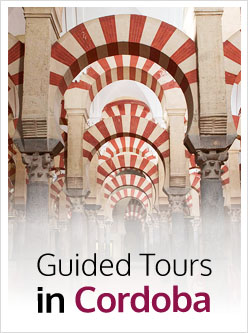

Choose the tour that best suits your needs and book your place on one of our regular guided tours.
The regular guided tours are those that you can sign up for individually, are conducted regularly and in one language, Spanish or English
Guided Visit Mosque-Cathedral of Cordoba
5 / 5
13€
Guided Visit to the Mosque of Cordoba and the Jewish Quarter
5 / 5
Desde
17€
Guided Tour Cordoba in depth
5 / 5
Desde
40€
Guided Visit Medina Azahara
5 / 5
Desde
18€


